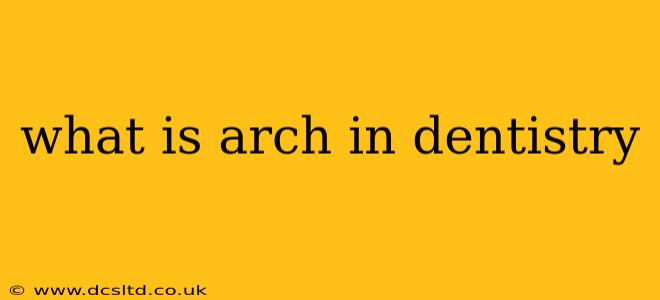In dentistry, the term "arch" refers to the curved arrangement of teeth in the upper (maxilla) and lower (mandible) jaws. These arches are crucial for proper chewing, speaking, and facial aesthetics. Understanding the dental arch is fundamental to various aspects of dental care, from orthodontics to restorative dentistry. This comprehensive guide will explore the key aspects of dental arches, answering common questions many patients have.
What are the two dental arches?
There are two dental arches: the maxillary arch (upper arch) and the mandibular arch (lower arch). These arches work together in a coordinated manner to perform essential oral functions. The maxillary arch is typically wider and more U-shaped than the mandibular arch, which tends to be more V-shaped. The relationship between these arches is vital for a healthy and functional bite.
What is the purpose of dental arches?
The primary purpose of the dental arches is to support the teeth and facilitate mastication (chewing). The curved arrangement of teeth allows for efficient grinding and breaking down of food. Furthermore, the arches contribute significantly to:
- Speech: The proper alignment and position of teeth within the arches are essential for clear articulation and pronunciation.
- Facial aesthetics: The shape and alignment of the dental arches significantly impact facial symmetry and overall appearance. A well-aligned arch contributes to a balanced and attractive smile.
- Jaw joint health: The proper relationship between the upper and lower arches is crucial for maintaining the health of the temporomandibular joints (TMJs), which connect the jaw to the skull. Malalignment can lead to TMJ disorders.
How many teeth are in each arch?
A fully developed adult human typically has 16 teeth in each arch, totaling 32 teeth in the mouth. This includes incisors, canines, premolars, and molars. Children have fewer teeth initially, with the permanent teeth gradually replacing the primary (baby) teeth.
What are the different parts of a dental arch?
Each dental arch can be further divided into specific regions:
- Incisor region: Located at the front of the mouth, incisors are responsible for cutting food.
- Canine region: Situated next to the incisors, canines are the pointed teeth used for tearing food.
- Premolar region: These teeth are located behind the canines and assist in grinding food.
- Molar region: These teeth, situated at the back of the mouth, are crucial for grinding and crushing food.
What are some common problems related to dental arches?
Several problems can affect the dental arches, including:
- Malocclusion: This refers to improper alignment of the teeth and jaws, often requiring orthodontic treatment.
- Crowding: When there's insufficient space in the arch for all the teeth to erupt properly.
- Spacing: Excessive spacing between teeth, potentially leading to aesthetic concerns and functional issues.
- Arch collapse: Loss of teeth can lead to the collapse of the arch, affecting the alignment of remaining teeth and overall bite.
How are dental arches diagnosed?
Dentists use various methods to assess dental arches, including:
- Visual examination: A thorough visual inspection of the teeth and jaws.
- Radiographs (X-rays): To examine the roots of the teeth and underlying bone structures.
- Models: Taking impressions of the teeth and jaws to create plaster models for detailed analysis.
Understanding the dental arch is crucial for maintaining optimal oral health. Regular dental checkups are essential for early detection and treatment of any potential arch-related issues. A well-aligned and healthy arch contributes significantly to overall well-being, influencing not only chewing and speaking but also facial aesthetics and overall confidence.
